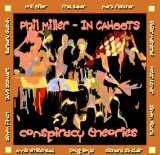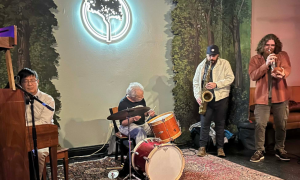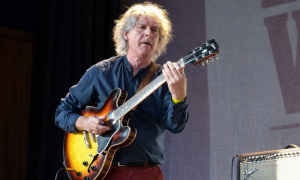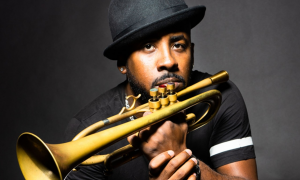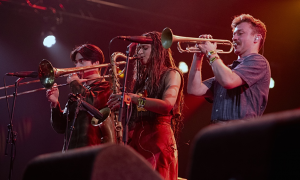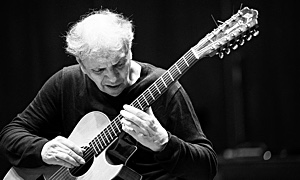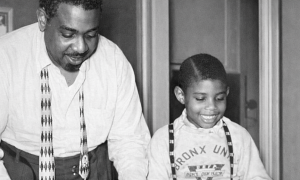Home » Jazz Articles » Live Review » Ottawa Jazz Festival Day 2: June 22, 2007
Ottawa Jazz Festival Day 2: June 22, 2007
While musical cross-pollination has become de rigueur in today's global community, jazz has always been a fertile testing ground. Day two of the TD Canada Trust Ottawa International Jazz Festival demonstrated, in no uncertain terms, that the joining together of seemingly incongruous musical styles into a new whole is not only possible but is in many ways what it's all about and is essential to jazz's ongoing evolution.
Chapter Index
While the storytelling tradition is often most closely associated with the folk music community, pianist Joey Calderazzo's 5:00 PM solo performance at the Connoisseur Series demonstrated that there's room for it in jazz as well.
Arriving a little late to the Library and Archives Canada theatre due to unexpected rush hour traffic, Calderazzo took to the stage, picked up a microphone and set some context for the music to follow. Virtually every pianist who has played the Library's legendary Steinway (originally belonging to Glenn Gould and used by pianist Bill Evans on his classic 1963 Verve release, Conversations With Myself) has felt it a certain privilege, and Calderazzo was no exception. "Glenn Gould is going to be turning over in his grave," quipped Calderazzo, who then went on to describe his "illustrious" educational background, including three days spent at Boston's Berklee College of Music, four days at New York's Manhattan School of Music and two equally brief attempts at Long Island University. "Someday I'll probably get an honorary degree from them," he said jokingly.
 Then again, that may not be far from the truth. Calderazzo is the definition of the self-taught, road- experienced musician who, with a couple of lucky (but well-deserved) breaks, got the chance to develop his talent at an early age with the late saxophonist Michael Brecker and, of course, saxophonist Branford Marsalis, with whom he performed at the first day of the festival.
Then again, that may not be far from the truth. Calderazzo is the definition of the self-taught, road- experienced musician who, with a couple of lucky (but well-deserved) breaks, got the chance to develop his talent at an early age with the late saxophonist Michael Brecker and, of course, saxophonist Branford Marsalis, with whom he performed at the first day of the festival.
Drawing on material from his two solo piano releases—Haiku (Marsalis Music, 2003) and Amanecer (Marsalis Music, 2007)— the 42 year-old pianist launched into a set that ranged from original music (the elegiac "Hope," dedicated to Brecker) to lengthy explorations of well-known standards (Evans' "Waltz for Debby"). Calderazzo may work with form, but its application is always liberal and open. "Waltz for Debby" began amorphously, gradually working its way to the familiar theme and a more defined rhythm. Throughout the set Calderazzo's nothing-to-prove style mixed dense harmonies with lithe melodies.
The multitude of pianists— including Thelonious Monk, Bill Evans, Chick Corea, McCoy Tyner, Herbie Hancock and Keith Jarrett—who have inspired him would have been easy to identify even if he'd not identified them to the audience at one point during the set. But by this point Calderazzo has emerged as a singular voice in his own right, one that references those influences without imitating them.
There were unequivocally serious moments, but Calderazzo's playful approach was a more definitive characteristic of the ninety-minute set, with the pianist glancing mischievously at the audience when he executed a particularly challenging passage. Calderazzo's constant engagement with his audience turned an impressive solo piano performance into an even more memorable experience by providing a rarely seen and crystal clear window into the artist's life and work. class="f-right">
King Crimson's Robert Fripp has often described studio albums as love letters and live performance a hot date. Veteran saxophonist and Miles Davis alumnus Bill Evans brought his Soulgrass project to the 8:30 PM Concert Under the Stars and, for the festival's appreciative audience braving below average temperatures, it was one very hot date indeed.
Evans' Soulgrass (Vansman, 2005) is an undeniably strong debut for a concept that some will compare too closely to banjo icon Béla Fleck's blending of bluegrass and jazz. Fleck and a laundry list of other high octane names—including "newgrass" mandolinist Sam Bush, fiddler Stuart Duncan and guitarist Pat Bergeson, alongside Flecktones bassist Victor Wooten, pianist Bruce Hornsby and guitarist John Scofield—rub shoulders on Evans' disc for some fine results, but in almost every way Evans' touring band— young banjoist Ryan Cavanaugh, violinist Christian Howes, bassist David Livolsi and drummer Joel Rosenblatt—whipped the music, largely culled from Soulgrass, into far more exciting shape.
 While Fleck and the Flecktones spearheaded a more definitive merging of bluegrass and jazz, its music is inherently complex and idiosyncratic. Over the years, as the band has become a jamband favorite, it has also evolved into a performing act where virtuosity is number one with, in many cases, groove a distant second. Evans' group, while certainly no less accomplished, turns the concept around, with Livolsi and Rosenblatt's unshakable (and booty shaking) grooves far more direct and visceral. There's no shortage of interplay and fine soloing, but the group's soulful approach is a refreshing alternative to The Flecktones' music which, in recent times, has begun to sound a little too considered and contrived.
While Fleck and the Flecktones spearheaded a more definitive merging of bluegrass and jazz, its music is inherently complex and idiosyncratic. Over the years, as the band has become a jamband favorite, it has also evolved into a performing act where virtuosity is number one with, in many cases, groove a distant second. Evans' group, while certainly no less accomplished, turns the concept around, with Livolsi and Rosenblatt's unshakable (and booty shaking) grooves far more direct and visceral. There's no shortage of interplay and fine soloing, but the group's soulful approach is a refreshing alternative to The Flecktones' music which, in recent times, has begun to sound a little too considered and contrived.
Since first emerging with Davis' early-1980s comeback band, Evans has built a busy and successful career working with jazz notables including Mike Mainieri/Steps Ahead, John McLaughlin and the late Gil Evans. A widely versed saxophonist who's always looking for new ways to bring seemingly disparate styles together, his collaboration with trumpeter Randy Brecker on Soulbop Band Live (BHM, 2006), was a substantial and entertaining effort. But the spontaneous energy and more distinctive crossover sound of Soulgrass possesses far greater potential. While Europe and the Far East remain more supportive markets for many jazz musicians, Evans sees this group as having a better chance at making the United States its primary focus.
Livolsi and Rosenblatt provided an unassailable foundation throughout the ninety-minute set, but equally kept their ears open to what was going on around them. Howes, a local favorite since appearing at OIJF in past years, demonstrated, once again, that there seems to be nothing beyond his reach. From soaring lines to gritty bluegrass harmonies, his ever-growing musical language made for some of the show's most exciting moments.
 But the real surprise of the set was banjoist Ryan Cavanaugh. At 27 he may be a new name to most, but that won't last long, as he's poised to parallel Béla Fleck's legitimizing of the banjo in contemporary jazz. Cavanaugh's bluegrass credibility is undeniable but, while he'll humbly tell you that he's still got so much to learn, he's already a remarkable jazz player. With a more aggressive edge than Fleck, Cavanaugh's sometimes overdriven, rock-influenced tone and rapid-fire delivery suggest how John McLaughlin might sound had he picked up a banjo instead of a guitar. No surprise, really, since McLaughlin is one of Cavanaugh's staunchest advocates and recommended him to Evans in the first place.
But the real surprise of the set was banjoist Ryan Cavanaugh. At 27 he may be a new name to most, but that won't last long, as he's poised to parallel Béla Fleck's legitimizing of the banjo in contemporary jazz. Cavanaugh's bluegrass credibility is undeniable but, while he'll humbly tell you that he's still got so much to learn, he's already a remarkable jazz player. With a more aggressive edge than Fleck, Cavanaugh's sometimes overdriven, rock-influenced tone and rapid-fire delivery suggest how John McLaughlin might sound had he picked up a banjo instead of a guitar. No surprise, really, since McLaughlin is one of Cavanaugh's staunchest advocates and recommended him to Evans in the first place.
Perhaps the greatest appeal of Evans and Soulgrass is the sheer fun that the group is clearly having, as its fusing of jazz and bluegrass provides everyone with something to learn. For Cavanaugh it's the language of jazz; for Evans and Howes it's bluegrass. You'd never know it, though, as the quintet worked its way through danceable grooves, intertwining melodies and extended soloing. Nor did the audience, who refused to let the group leave without an encore. There's a new Soulgrass album in the works that will feature, amongst another large cast of players, the members of this remarkable touring band. That's a very good thing but, based on last night's performance, what would be even better would be a live album from this exciting group. class="f-right">
Shanghai-based singer Coco Zhao brought a different kind of stylistic fusion to his 10:30 PM Studio series show. His 2006 debut on the Canadian Effendi label, Dream Situation, brought together ethnic songs with a more jazz-centric improvisational approach. He may sing in Chinese, but the resonance of his interpretive voice makes understanding the words moot. Emotional yet often subdued and restrained, Zhao's set was easy on the ears yet filled layered with substance.
 Eschewing the piano-bass-drums format of Dream Situation, Zhao instead brought an unconventional quartet feature guitarist Sylvain Provost, vibraphonist Jean Vanasse and bassist Marc Lalonde. The trio played an opening instrumental reminiscent of the best guitar/vibes pairings of Gary Burton before Zhao took the stage, along with violinist Peng Fei, a member of Zhao's working band in Shanghai. The instrumental combination created a gentle atmosphere, bordering at times on the ethereal, but always kept close to the ground by Lalonde. Fei integrated a distinctly Oriental ambience to his playing through use of soft harmonics and a wide vibrato that, at times, added an almost microtonal aspect.
Eschewing the piano-bass-drums format of Dream Situation, Zhao instead brought an unconventional quartet feature guitarist Sylvain Provost, vibraphonist Jean Vanasse and bassist Marc Lalonde. The trio played an opening instrumental reminiscent of the best guitar/vibes pairings of Gary Burton before Zhao took the stage, along with violinist Peng Fei, a member of Zhao's working band in Shanghai. The instrumental combination created a gentle atmosphere, bordering at times on the ethereal, but always kept close to the ground by Lalonde. Fei integrated a distinctly Oriental ambience to his playing through use of soft harmonics and a wide vibrato that, at times, added an almost microtonal aspect.
Zhao's singing was deeply nuanced, oftentimes so subtle that when he raised his voice even the slightest it created vivid drama. Singing softly and with an appealing vibrato, his ability to cross-pollinate an understated kind of scat provided the nexus between two very different musical worlds. A memorable show from a singer with significant potential. class="f-right">
Late Night Jam Session
With bassist John Geggie back as the host of the late night jam sessions, taking place at the festival hotel (Holiday Inn Hotel & Suites), it only took two days to return things to the way they were when he last hosted them for a number of years, ending (thankfully only temporarily) in 2004. Geggie's core trio—featuring Toronto-based drummer Nick Fraser, and with fellow-Torontonian pianist Nancy Walker sharing the piano chair with Montreal's Josh Rager—is good enough to carry things on quiet evenings and flexible enough to adapt to whatever surprises might come up on busy ones. It's an essential skill for jam session groups, where you never know who will show up looking to play, whether it's local artists or those visiting the festival from farther afield.
Packed to the rafters by 11:00 PM, the jam session was definitely the place to be on the second night the festival. Soulgrass drummer Joel Rosenblatt, banjoist Ryan Cavanaugh and violinist Christian Howes joined the trio on the room's small stage, prompting Geggie to remark, in his usual dry fashion, that the goal was "to see how many musicians we can fit onstage."
But before the sextet (soon to be septet with the inclusion of Ottawa saxophonist Petr Cancura) took off into jazz territory, Howes and Cavanaugh delivered a pair of high velocity bluegrass duets, with Cavanaugh providing a brief history of bluegrass. The connection with Celtic music is clear, but so, too, is the integration of American blues, prompting Cavanaugh to shout "Bluegrass is fusion!" Based on his remarkable integration of traditional banjo finger-picked arpeggios with staggeringly fast lines that spoke of a more expansive language, he didn't have to say much; the evidence was all there for the ears to experience. Howes later mentioned how he was still learning bluegrass, but you'd never have known it from these two duets.

When Rosenblatt joined the stage it became immediately clear that, while he was a hard-grooving funk- meister with Soulgrass, he was an equally flexible drummer, swinging hard and fast alongside Geggie. Bill Evans, who was at the jam but chose to relax and talk to his fans, spoke about how, for this project, he needed to find players who knew bluegrass, jazz and more in order to make a collective capable of taking those roots and somewhere new. Listening to Cavanaugh, Howes and Rosenblatt onstage with Geggie and Rager (a young pianist on the rise, who was as flexible and impressive as everyone else) was further evidence to the argument that artists' personal musical choices don't necessarily reflect everything about them; instead, they simply reflect where they are at a particular point in time.
Staged performances have, of course, their own appeal, but for some of the most spontaneous and unexpected moments at the OIJF, the late night jam session is definitely the place to be.
Tomorrow: Pianists Junior Mance and Dave Brubeck.
Visit Joey Calderazzo, Bill Evans, Christian Howes, Ryan Cavanaugh, Dave Livolsi, Joel Rosenblatt, John Geggie, Nick Fraser, Josh Rager and the TD Canada Trust Ottawa International Jazz Festival on the web.
Photo Credits
Joey Calderazzo, Coco Zhao, Christian Howes: John Fowler
Bill Evans, Ryan Cavanaugh: John Kelman
Day 1 | Day 2 | Day 3 | Day 4 | Day 5 | Day 6 | Day 7 | Day 8 | Day 9 | Day 10 | Day 11
Tags
PREVIOUS / NEXT
Support All About Jazz
 All About Jazz has been a pillar of jazz since 1995, championing it as an art form and, more importantly, supporting the musicians who make it. Our enduring commitment has made "AAJ" one of the most culturally important websites of its kind, read by hundreds of thousands of fans, musicians and industry figures every month.
All About Jazz has been a pillar of jazz since 1995, championing it as an art form and, more importantly, supporting the musicians who make it. Our enduring commitment has made "AAJ" one of the most culturally important websites of its kind, read by hundreds of thousands of fans, musicians and industry figures every month.



